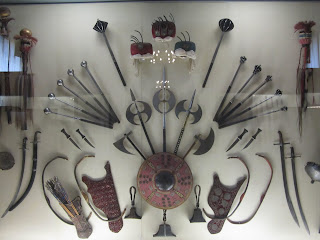Back to Vienna and another museum. This time it was the Heeresgeschichtliches Museum. (Yes, that is what it is really called.) In English, we would the military history museum. I was really interested in this museum as I have been to many military history museums back home and I was anxious to compare. After walking through the grand entrance hall, I headed straight for the World War I exhibit, especially that of Archduke Franz Ferdinand. In this exhibit is the car tin which the archduke and his wife Archduchess Sophie were assassinated. I could see the bullet from one of the shots. Next to this exhibit was a glass case that held the uniform worn by the archduke when he was shot and the chaise lounge on which he bled to death. His uniform has two large slashes where doctors tried to fined his wound. At first they missed the small bullet whole in the collar of his uniform that pierced his neck. The archducal couple were assassinated in Sarajevo by a nationalist youth who was a member of the black hand.
 I then continued with the rest of the exhibit. There were numerous uniforms from the different parts of the Austrian military. They had iron bunker roofs that had the dents from exploded Russian shells and an aircraft, which was from what would have been the new air force during WWI. They also had Allied uniforms on exhibit--one British and one American. This struck me with the thought that my country was the enemy of Austria in the war. I then realized this was the first time I had been in a military history museum where I was from the enemy country. I have been so used to viewing military history from a most often victorious American perspective that it really struck me to view WWI from the defeated side.
I then continued with the rest of the exhibit. There were numerous uniforms from the different parts of the Austrian military. They had iron bunker roofs that had the dents from exploded Russian shells and an aircraft, which was from what would have been the new air force during WWI. They also had Allied uniforms on exhibit--one British and one American. This struck me with the thought that my country was the enemy of Austria in the war. I then realized this was the first time I had been in a military history museum where I was from the enemy country. I have been so used to viewing military history from a most often victorious American perspective that it really struck me to view WWI from the defeated side. I continued upstairs with the exhibit of the Austrians and the Ottoman Turks. Again their was a large collection of military paraphernalia only this time predominately from the late 17th century. This collection included a captured Turkish military tent. The art from this time depicting the battles is really interesting. The depiction of the Austrians and their fellow Christian allies is that of light skinned very heroic looking soldiers gifted by the grace of Christendom for victory. The Turkish Muslims, on the other hand are most often portrayed as darker skinned and more animal like. In this context, they are not gifted with the heroic power of Christianity.
While this museum was built as an arsenal after the Revolutions of 1848, it was still built with extraordinary splendor. The entrance hall is covered in marble and statues of the great military leaders in Austrian history. It is the most beautiful and seemingly impractical arsenal I’ve ever seen. This further lends itself to the continuing theme of the Habsburgs portraying their power visually through many forms of art and architecture. The exterior of the arsenal is an imposing fortress that looks like it was built in the Medieval period. Instead it was built by Emperor Franz Josef I in another of his beloved historical styles.
 After we finished the military history museum, Diane and I headed back to the Kunsthistorisches Museum. This time we viewed the exhibit on the antiquities of Egypt, Greece, and Rome. The first part of the exhibit was Egyptian. Then came the Greek and Roman, which seemed not to be organized in a chronological way. While this made it a little confusing, it was still an amazing exhibit filled with Hellenistic pieces from Greece’s Golden Age and Roman portrait heads from the republican time of the Empire forwards. Their was also a large exhibit on jewelry, which I found interesting. I really enjoyed seeing all the carved cameos because I was previously unaware of this form of Roman art. While it was confusing at times, I appreciated all the pieces from the ancient civilizations.
After we finished the military history museum, Diane and I headed back to the Kunsthistorisches Museum. This time we viewed the exhibit on the antiquities of Egypt, Greece, and Rome. The first part of the exhibit was Egyptian. Then came the Greek and Roman, which seemed not to be organized in a chronological way. While this made it a little confusing, it was still an amazing exhibit filled with Hellenistic pieces from Greece’s Golden Age and Roman portrait heads from the republican time of the Empire forwards. Their was also a large exhibit on jewelry, which I found interesting. I really enjoyed seeing all the carved cameos because I was previously unaware of this form of Roman art. While it was confusing at times, I appreciated all the pieces from the ancient civilizations. 

No comments:
Post a Comment